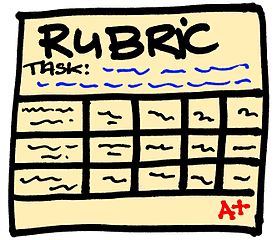CTVSD2/Rubrics/Introduction
A rubric is a set of criteria that includes descriptions of levels of performance on the criteria. Sounds more simple than it is. This simple definition makes it clear that rubrics have two major aspects:
- sets of criteria and
- descriptions of levels of performance for these criteria.
The main purpose of rubrics is to assess performance. You can use them when you observe the learner in the process of doing something, like using an electric drill or solving a problem, or when you observe the product that is the result of the learner’s work, like a finished bookshelf or a written report.
Below is a list of some common types of performance that can be assessed with rubrics for you to get an idea when you can use them.
| Type of performance |
Examples |
Processes
|
|
Products
demonstrate understanding of concepts |
|
What is good about rubrics is that they are descriptive rather than evaluative. They are developed to match the performance to the description rather than "judge" it. There are instances you may come across, in which the performance descriptions are called ‘judgment statements’ as they assist the assessor to make a judgement or a decision on the performance.
Assessment rubrics are as good as the criteria selected (the elements of the assessed performance) and the descriptions of the levels of performance under each criteria. To design effective rubrics you need to have appropriate criteria and well-written descriptions of performance or 'judgment statements'.
If you are not familiar with rubrics we recommend you view the following videos and resources before you start working on your rubric.
When ready click next to see some examples of draft rubrics and completed rubrics, as well as additional resources to assist you when designing your rubrics.
